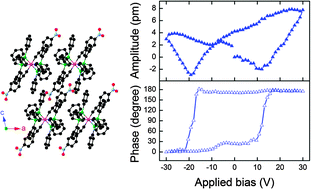Dipolar molecular crystals present different physical properties from traditionally strongly correlated ionic solid-state inorganic crystals due to the weak intermolecular bonding. Herein, centrosymmetric dipolar molecular crystals of the organoruthenium complex trans-[Ru(C![[triple bond, length as m-dash]](http://www.rsc.org/images/entities/char_e002.gif) CC6H4-4-NO2)(C
CC6H4-4-NO2)(C![[triple bond, length as m-dash]](http://www.rsc.org/images/entities/char_e002.gif) CPh)(dppe)2] [dppe = 1,2-bis(diphenylphosphino)ethane] display a large electric-field-induced strain behaving differently from conventional piezoelectric materials that must, structurally, be noncentrosymmetric. Further studies of related systematically varied crystalline organoruthenium complexes reveal that the strong electromechanical coupling effect is not from classical ferroelectricity, electrostriction, flexoelectricity or electrochemical strain. It is, instead, attributed to the disorder in the molecular packing, which facilitates reorientation of the molecular dipoles under the action of an applied electric field. This provides a fresh insight into the design and development of new functional materials and a promising source of electromechanical coupling in organometallic, and more generally dipolar molecular, crystals.
CPh)(dppe)2] [dppe = 1,2-bis(diphenylphosphino)ethane] display a large electric-field-induced strain behaving differently from conventional piezoelectric materials that must, structurally, be noncentrosymmetric. Further studies of related systematically varied crystalline organoruthenium complexes reveal that the strong electromechanical coupling effect is not from classical ferroelectricity, electrostriction, flexoelectricity or electrochemical strain. It is, instead, attributed to the disorder in the molecular packing, which facilitates reorientation of the molecular dipoles under the action of an applied electric field. This provides a fresh insight into the design and development of new functional materials and a promising source of electromechanical coupling in organometallic, and more generally dipolar molecular, crystals.

